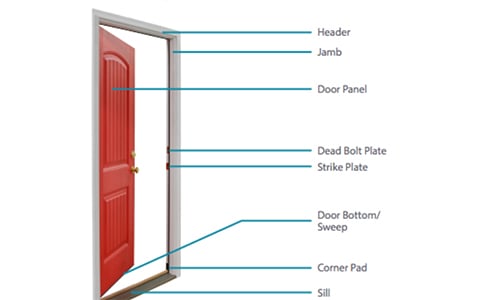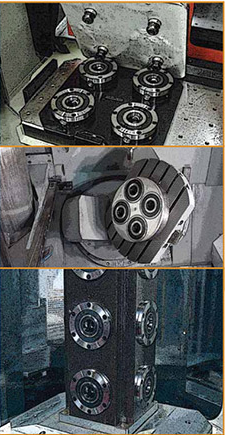Tightening Method Of Bolts And Selection Of Tightening Tools For Wind Turbine
Tightening Method Of Bolts And Selection Of Tightening Tools For Wind Turbine
This article mainly analyzes the difference between the pre-tightening force control and application of the hydraulic tensioner and the hydraulic torque wrench in the bolt connection of the wind turbine, so as to propose a reasonable and correct selection of tools to help ensure the construction progress, improve the construction efficiency, and ensure the construction quality. It can also better ensure the safe, stable and long-term operation of the wind turbine.
Most important parts of the wind turbine installation process are connected by bolts. In the process of bolt tightening, there is generally a requirement for pre-tightening force. Large-scale bolt connection is very important, and necessary pre-tightening force control is an important condition to ensure the reliability and tightness of the connection.
Two methods for tightening assembly bolts of wind turbines
Torque tightening method
At present, the most widely used bolt connection pre-tightening process in the wind power industry is the torque tightening method. Through the torque value set by the torque wrench, the torque is indirectly converted into tensile force to realize the pre-tightening of the bolt. The advantage is simple and intuitive. There are two series of hydraulic wrenches: driven hydraulic torque wrenches and hollow hydraulic wrenches. The driven hydraulic torque wrench is used in conjunction with a standard socket. It is a universal hydraulic wrench with a wide range of applications. It can be almost applied to the fastening of the bolt connection parts of various large specifications in the installation of wind turbines. The hollow hydraulic wrench has a thin thickness, which is especially suitable for places with relatively small space, such as the connection between the hub and the blade of a wind turbine.
The working principle of hydraulic torque wrench: hydraulic torque wrench is composed of working head, hydraulic pump and high pressure oil pipe. Through the high-pressure oil pipe, the hydraulic pump transmits the power to the working head, and drives the working head to tighten or loosen the nut.
Due to the tightening torque T generated by the hydraulic torque wrench, a pre-tightening force F0 is generated between the bolt and the connected part. The tightening torque T is equal to the sum of the frictional resistance torque T1 between the screw pairs and the frictional resistance torque T2 between the annular end surface of the nut and the supporting surface of the connected piece (or washer). The formula is as follows:
T=T1 +T2 =KF0d
d—— — Nominal diameter of thread, mm;
F0 —— — Pre-tightening force, N;
K—— — Tightening torque coefficient.
The tightening coefficient K is related to the thread surface and flange roughness, lubrication condition, tightening speed, tools and ambient temperature, etc. It usually varies between 0.1 and 0.3. Under a certain tightening torque, the pre-tightening force changes relatively large, so the accuracy of controlling the bolt pre-tightening force through the tightening torque is not high, and the error is about ±25%, and the maximum can reach ±40%.
Hydraulic tension pre-tightening method
The working principle of the bolt hydraulic tensioner: the bolt hydraulic tensioner is abbreviated as the bolt tensioner. The oil pressure generated by the hydraulic booster pump (ultra-high pressure oil pump) is transmitted to the piston surface of the tensioner through the oil pipe and is pulled by hydraulic pressure. The tensioning head on the stretcher interacts with the tensioned bolt to stretch the bolt. After reaching the set pressure, tighten the nut with a lever or a wrench to make the nut fit the surface of the fastener correctly, and after the pressure is relieved To achieve the purpose of tightening the nut.
Due to the influence of various factors such as bolt diameter, length, thread form, pitch, abutting surface conditions, and axial coaxiality, the final axial force obtained on the bolt is not equal to the force exerted on the bolt by the hydraulic cylinder at the beginning. A certain loss. In engineering, the set tension Fh of the hydraulic tensioner is generally greater than the pre-tightening force F0. The ratio between the two is mainly related to the slenderness ratio of the bolt clamping part. For ordinary metric coarse-thread bolts, the recommended formula is:
Fh/F0 = 1.15+2/G2=1.15+2/(Lk/d)2
G is the slenderness ratio of the bolt clamping part, that is, the length of the bolt clamping part/the nominal diameter of the bolt. Lk is the length of the bolt clamping part, mm. d is Nominal diameter of bolt, mm;
Fh is set tension of hydraulic tensioner, N; F0 bolt pre-tightening force, N.
Therefore, for the fan bolt joints with different bolt clamping lengths and diameters, the set tension Fh of the hydraulic tensioner can be calculated by the formula according to the required bolt pre-tightening force F0.
From the above analysis of the torque tightening method and the hydraulic tension pre-tightening method, it can be seen that there are too many factors that affect the tightening coefficient K when the torque method is used to pre-tighten the bolt, and many factors are uncontrollable. Under the same construction torque, the bolt pre-tightening force can only be controlled within a certain range, but the axial tensile force required by the design cannot be obtained, resulting in under-tightening or over-tightening of the bolt, and the bolt will loosen or damage the bolt. The connection strength and quality cannot be guaranteed. Compared with the torque method, when the hydraulic tensioner is used, the set tensile force corresponds to the pre-tightening force obtained by stretching, and the bolt is directly stretched to the specified pre-tightening force. This method controls the pre-tightening force more accurately, but due to the limitation of the installation position and space, the wind turbine can only use the hydraulic stretching method to pre-tighten the part of the connection.
Features of hydraulic tensioner and hydraulic torque wrench in the fan bolt connection:
(1) The salt spray corrosion in coastal areas is serious, and the connecting bolts of the fan are generally coated with anti-corrosion coating protection, usually dacromet or galvanized layer. If a torque wrench is used for tightening, the outer surface coating of the nut is easily damaged, which affects the anti-corrosion effect of the nut. However, the use of hydraulic tension tightening, because the torque transmitted by the nut sleeve to the nut is very small, so the anti-corrosion coating of the nut will not be damaged.
(2) The bolt tensioner uses pure tension to directly extend the bolt, without torsion shear and lateral force, and without friction damage to the contact surface of the connection. It is the best method to accurately control the bolt pre-tightening force. Compared with hydraulic torque wrenches, bolt tensioners have the advantages of rapid response and accuracy, no torsional stress, no frictional damage, and simultaneous pre-tightening of multiple bolts (using tubing distributors).
(3) The hydraulic torque wrench has good versatility, while the tension tube of the bolt tensioner needs to match the bolt pitch, etc., matching the threads one to one, which is not good for versatility. For bolts installed through hydraulic tensioners, tensioners must also be used for tightening in later maintenance and replacement.
(4) The construction period of using hydraulic tensioner is longer than hydraulic torque wrench
In the installation project of a 2.5MW direct drive wind turbine, the high-strength connecting bolts of the wind turbine are all tightened in stages, sequence, and multiple cycles; except that the connecting bolts between the hub and the blades are tightened by hollow hydraulic wrenches , The rest of the connection parts a+++++++re required to be tightened with a tensioner.
According to statistics and calculations on the construction site, the same group of workers used a hydraulic torque wrench to tighten the connecting bolt M36 between the hub and the blade, and an average of 36s tightened 1 bolt; using a pneumatic hydraulic tensioner (this tool is provided by the manufacturer.) When tightening the connecting bolts between the foundation and a section of the tower, tighten 2 bolts in an average of 180s (use a distributor to pre-tighten the 2 bolts); use an electro-hydraulic tensioner (this tool is provided by the fan manufacturer) to tighten When fixing the remaining high-strength connecting bolts, tighten 2 bolts in an average of 110s (use a distributor to pre-tighten the 2 bolts simultaneously). Therefore, compared with the use of hydraulic tensioners to tighten the bolts of the direct-drive fan hoisting joints, if one set of hydraulic wrenches are used to work, regardless of the influence of other factors, the tightening time will be directly reduced: 26.83-15.12=11.71d, Approximately 1.5 working days; if multiple sets of hydraulic wrenches are used to tighten the bolts of each installation platform at the same time, the lifting time will be greatly reduced.
Because the wind turbine installation process requires that the last section of the tower and the nacelle must be hoisted on the same day, if the extra working time during the bolt tightening process is affected by weather such as strong winds and rainfall, the construction schedule and construction period will be significantly affected. Therefore, when bidding, the construction team should pay attention to whether the hoisted fan requires the use of hydraulic tensioners to fasten the connecting bolts of the fan. This key process will affect the construction progress and cost.
Written at the end:
Compared with hydraulic torque wrenches, the anti-corrosion layer on the surface of the bolt tensioner is not easy to damage, simple operation, no torque coefficient requirements for the bolt connection, simple bolt force, high pre-tightening precision, bolts are not easy to loose, and the amount of later maintenance is small. During installation It takes a lot of time; according to the requirements of different wind turbine manufacturers and on-site conditions, a reasonable and correct selection of tools will help us ensure the construction progress, improve construction efficiency, ensure the construction quality and the safe, stable, and long-term operation of the wind turbine.


